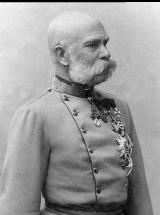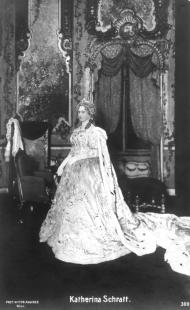¿Quién salió con Franz Joseph I of Austria?
Anna Nahowski salió con Franz Joseph I of Austria del ? al ?. La diferencia de edad fue de 28 años, 10 meses y 0 días.
Katharina Schratt salió con Franz Joseph I of Austria del ? al ?. La diferencia de edad fue de 23 años, 0 meses y 24 días.
Franz Joseph I of Austria

Franz Joseph I or Francis Joseph I (German: Franz Joseph Karl [fʁants ˈjoːzɛf ˈkaʁl]; Hungarian: Ferenc József Károly [ˈfɛrɛnt͡s ˈjoːʒɛf ˈkaːroj]; 18 August 1830 – 21 November 1916) was Emperor of Austria, King of Hungary, and the ruler of the other states of the Habsburg monarchy from 2 December 1848 until his death in 1916. In the early part of his reign, his realms and territories were referred to as the Austrian Empire, but in 1867 they were reconstituted as the dual monarchy of Austria-Hungary. From 1 May 1850 to 24 August 1866, he was also president of the German Confederation.
In December 1848, Franz Joseph's uncle Emperor Ferdinand I abdicated the throne at Olomouc, as part of Minister President Felix zu Schwarzenberg's plan to end the Hungarian Revolution of 1848. Franz Joseph then acceded to the throne. In 1854, he married his first cousin Duchess Elisabeth in Bavaria, with whom he had four children: Sophie, Gisela, Rudolf, and Marie Valerie. Largely considered to be a reactionary, Franz Joseph spent his early reign resisting constitutionalism in his domains. The Austrian Empire was forced to cede its influence over Tuscany and most of its claim to Lombardy–Venetia to the Kingdom of Sardinia, following the Second Italian War of Independence in 1859 and the Third Italian War of Independence in 1866. Although Franz Joseph ceded no territory to the Kingdom of Prussia after the Austrian defeat in the Austro-Prussian War, the Peace of Prague (23 August 1866) settled the German Question in favour of Prussia, which prevented the unification of Germany from occurring under the House of Habsburg.
Franz Joseph was troubled by nationalism throughout his reign. He concluded the Austro-Hungarian Compromise of 1867, which granted greater autonomy to Hungary and created the dual monarchy of Austria-Hungary. He ruled peacefully for the next 45 years, but personally suffered the tragedies of the execution of his brother Emperor Maximilian I of Mexico in 1867, the suicide of his son Rudolf in 1889, and the assassinations of his wife Elisabeth in 1898 and his nephew and heir presumptive, Archduke Franz Ferdinand, in 1914.
After the Austro-Prussian War, Austria-Hungary turned its attention to the Balkans, which was a hotspot of international tension because of conflicting interests of Austria with not only the Ottoman but also the Russian Empire. The Bosnian Crisis was a result of Franz Joseph's annexation in 1908 of Bosnia and Herzegovina, which had already been occupied by his troops since the Congress of Berlin (1878). On 28 June 1914, the assassination of Archduke Franz Ferdinand in Sarajevo resulted in Austria-Hungary's declaration of war against the Kingdom of Serbia, which was an ally of the Russian Empire. This activated a system of alliances declaring war on each other, which resulted in World War I. Franz Joseph died in 1916, after ruling his domains for almost 68 years. He was succeeded by his grandnephew Charles I & IV.
Leer más...Anna Nahowski

Anna Nahowski (* 18. Juni 1859 als Anna Nowak in Wien; † 23. März 1931 ebenda) war in den 1870er und 1880er Jahren Geliebte von Kaiser Franz Joseph I. von Österreich.
Leer más...Franz Joseph I of Austria

Katharina Schratt

Katharina Schratt (Baden bei Wien, Austria 11 de septiembre de 1853- Viena, 17 de abril de 1940) fue una actriz austríaca que se convirtió en la "Emperatriz de Austria sin corona", amante y confindente del emperador Francisco José.
Era la única hija de un oficial proveedor, y tenía dos hermanos. Ya a la edad de 6 años estaba interesada en el teatro. Los esfuerzos de sus padres para desanimarla en su carrera aumentaron su ambición. Cuando tenía 18 años, se presentó como parte de la compañía del Hoftheater en Berlín, donde pudo alcanzar considerables éxitos después de poco tiempo. De todos modos, ella solamente se quedó unos pocos meses en Alemania, con el objetivo de participar en el teatro de la ciudad de Viena.
Schratt se casó con el aristócrata húngaro Nikolaus Kiss de Ittebe en 1879, y tuvieron un hijo, Anton, en 1880. Después de aparecer en Nueva York, volvió permanentemente a Hofburgtheater de Viena como una de las actrices más populares de Austria, hasta que se retiró en 1900.
Como actriz, la interpretación de Katharina en la Exhibición Industrial de Viena en 1885 atrajo la atención del emperador Francisco José I, y fue invitada para actuar por visitar a Alejandro III, el Zar ruso.
La esposa de Francisco José, la emperatriz Isabel, en realidad promocionó la relación entre la actriz y el emperador, debido a intensas complicaciones de salud de la misma y compromisos asumidos por la emperatriz. La relación continuó, con pocas interrupciones hasta la muerte del emperador en noviembre de 1916.
Schratt fue galardonada con un estilo de vida generoso, incluyendo una mansión en Gloriettegasse, cerca del Palacio de Schönbrunn, en Viena, y un palacio en Kärntner Ring.
Katharina Schratt se retiró a este último después de la muerte del emperador, donde vivió completamente retirada. Muchos años después, Schratt se tornó profundamente religiosa. Y luego de su muerte en 1940 a la edad de 87 años, fue enterrada en el Cementerio Hietzing en Viena.
Leer más...